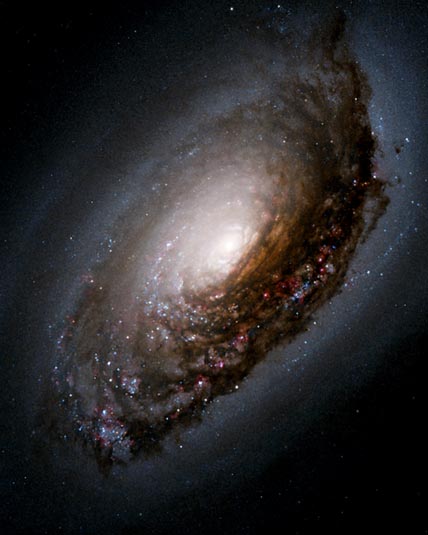
Gives One Galaxy a "Black Eye"
Spiral Galaxy
R.A. 12h 56m 43s.88 Dec. +21° 41' 00".1
Coma Berenices
Approximately 17 million light-years (5.2 Megaparsecs).
This image is roughly 1.5 arcminutes (7,400 light-years or 2,300 parsecs) wide.
WFPC2
April 8/July 6, 2001
1.1 hours
F450W (B), F547M (Strömgren y), F656N (H-alpha), F814W (I)
NASA and The Hubble Heritage Team (STScI/AURA)
February 5, 2004
ABOUT THIS IMAGE:
A collision of two galaxies has left a merged star system with an unusual appearance as well as bizarre internal motions. Messier 64 (M64) has a spectacular dark band of absorbing dust in front of the galaxy's bright nucleus, giving rise to its nicknames of the "Black Eye" or "Evil Eye" galaxy.
Fine details of the dark band are revealed in this image of the central portion of M64 obtained with the Hubble Space Telescope. M64 is well known among amateur astronomers because of its appearance in small telescopes. It was first cataloged in the 18th century by the French astronomer Messier. Located in the northern constellation Coma Berenices, M64 resides roughly 17 million light-years from Earth.
At first glance, M64 appears to be a fairly normal pinwheel-shaped spiral galaxy. As in the majority of galaxies, all of the stars in M64 are rotating in the same direction, clockwise as seen in the Hubble image. However, detailed studies in the 1990's led to the remarkable discovery that the interstellar gas in the outer regions of M64 rotates in the opposite direction from the gas and stars in the inner regions.
Active formation of new stars is occurring in the shear region where the oppositely rotating gases collide, are compressed, and contract. Particularly noticeable in the image are hot, blue young stars that have just formed, along with pink clouds of glowing hydrogen gas that fluoresce when exposed to ultraviolet light from newly formed stars.
Astronomers believe that the oppositely rotating gas arose when M64 absorbed a satellite galaxy that collided with it, perhaps more than one billion years ago. This small galaxy has now been almost completely destroyed, but signs of the collision persist in the backward motion of gas at the outer edge of M64.
This
image of M64 was taken with Hubble's Wide Field Planetary Camera 2 (WFPC2).
The color image is a composite prepared by the Hubble Heritage Team from
pictures taken through four different color filters. These filters isolate
blue and near-infrared light, along with red light emitted by hydrogen
atoms and green light from Strömgren y.